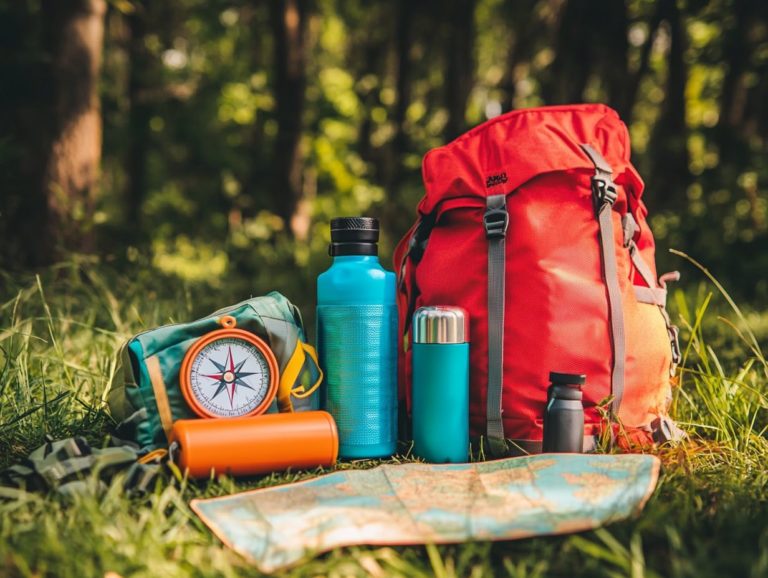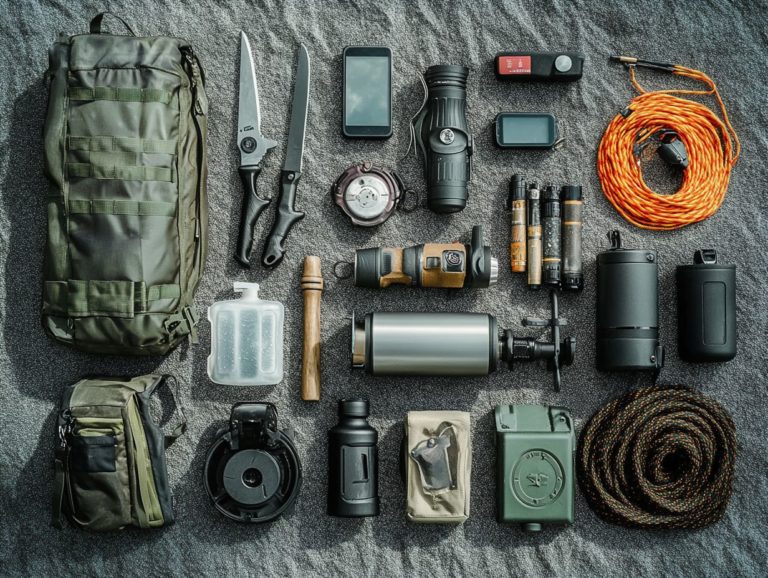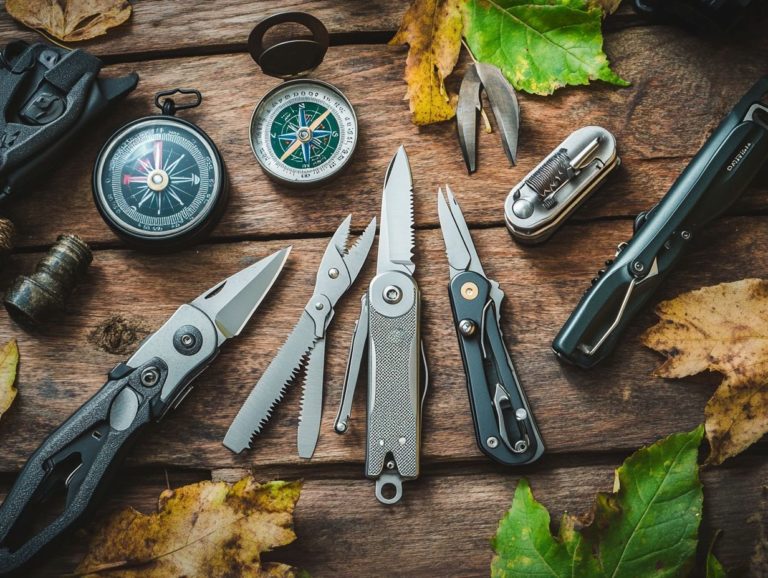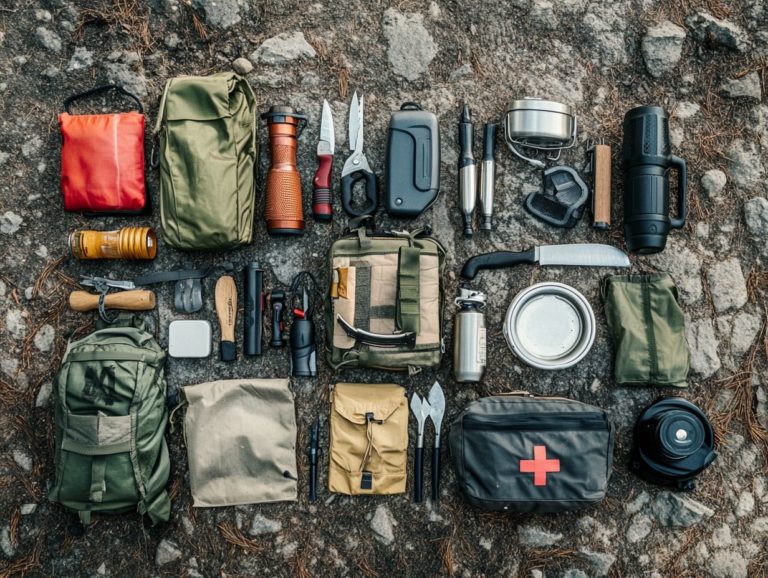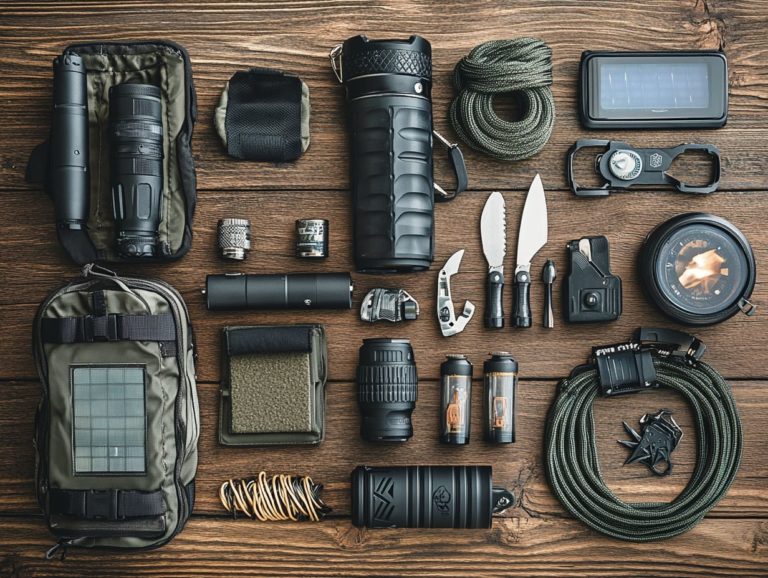The Best Survival Gear for Cold Weather
When winter s chill descends, being unprepared can transform a simple outing into a precarious situation. Whether you’re hiking in the mountains or unexpectedly facing a cold snap, having the right survival gear is essential.
This article delves into the essential items you need for cold weather survival from durable clothing and shelter tools to emergency food supplies and comprehensive first aid kits.
Get ready to uncover essential tips that will keep you safe and warm this winter!
Contents
- Key Takeaways:
- 1. Durable and Insulated Clothing
- 2. Shelter and Fire-Making Tools
- 3. Navigation and Communication Devices
- 4. Emergency Food and Water Supplies
- 5. First Aid Kit
- 6. Multi-Tool and Knife
- 7. Lighting and Signaling Tools
- 8. Personal Hygiene and Sanitation Items
- 9. Emergency Blankets and Sleeping Bags
- 10. Hand and Foot Warmers
- 11. Portable Stove and Fuel
- 12. Emergency Whistle
- 13. Emergency Radio
- 14. Waterproof Matches and Lighter
- 15. Survival Guide and Maps
- What Are the Essential Items for Cold Weather Survival?
- Frequently Asked Questions
- What is the best type of clothing to wear for cold weather survival?
- What essential items should I include in my cold weather survival kit?
- What type of shelter is best for cold weather survival?
- Should I bring a water filter for cold weather survival?
- What type of fire-starting materials should I pack for cold weather survival?
- Is it important to have a first aid kit for cold weather survival?
Key Takeaways:
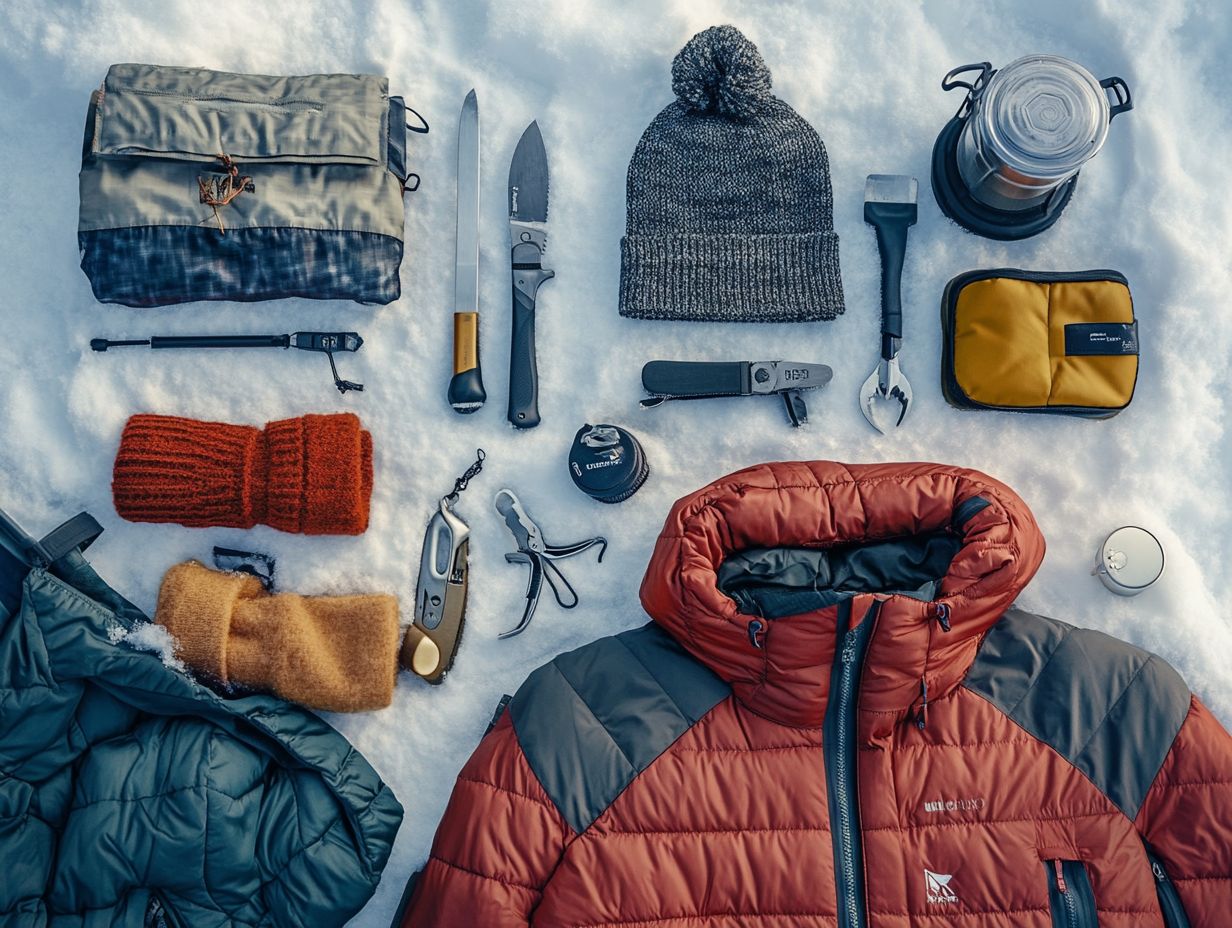
- Invest in durable, insulated clothing for extreme cold protection.
- Shelter and fire-making tools are vital for warmth and safety in cold weather.
- Use navigation tools to stay safe and find your way in emergencies.
1. Durable and Insulated Clothing
In cold weather, having durable and insulated clothing is essential for your protection against harsh elements and ensuring comfort during prolonged exposure to winter environments.
These garments not only provide warmth but are crafted from advanced materials that resist moisture and wind, making them perfect for outdoor activities like winter camping, hiking, or surviving a snowstorm.
Investing in high-quality winter clothing is a valuable investment. It keeps you warm and dry when it matters most.
Look for synthetic materials such as Primaloft, which provide great warmth without being heavy, and down feathers, celebrated for their superior insulation properties. Waterproofing features like breathable membranes keep moisture out, which is crucial for activities like skiing or snowshoeing.
Employing layering techniques is vital. Start with base layers that wick moisture away, add mid-layers for insulation, and finish with outer shells for wind and water protection. This approach allows you to adapt to changing conditions effortlessly.
By carefully selecting winter gear tailored to your specific activities and local climates, you can ensure you remain not just warm but also unencumbered, enhancing your performance and enjoyment in the great outdoors.
2. Shelter and Fire-Making Tools
When gearing up for a cold weather emergency, having a reliable shelter and effective fire-making tools is essential for your survival and comfort.
A well-constructed shelter shields you from biting winds and snowfall, serving as a mental refuge during harsh moments. Lightweight options like bivouac sacks are easy to carry, allowing for quick setups to minimize exposure to the elements. Tents offer more space and insulation, perfect for longer stays in frigid locations.
To complete your survival toolkit, fire-starting tools like magnesium fire starters and waterproof matches are invaluable. These tools help you ignite a fire for warmth and cooking, ensuring you have the nourishment necessary to withstand chilling temperatures.
In the winter wilderness, reliable navigation and communication devices are essential for safety and effective route planning, particularly in unfamiliar terrains.
Maps and compasses significantly enhance your ability to navigate challenging landscapes, providing crucial information that electronic devices might not deliver in remote areas. Portable chargers keep your smartphones and GPS units operational throughout your journey. Emergency radios maintain communication when cellular networks falter.
These tools help you stay oriented and play a critical role in your emergency preparedness. They allow you to signal for help or receive vital updates in unexpected situations, ensuring that you re always one step ahead of any challenges that may arise.
4. Emergency Food and Water Supplies
In an emergency, you must have adequate food and water supplies ready to sustain your energy and maintain hydration, especially in cold weather environments.
Foods that don’t spoil easily, like canned vegetables, dried fruits, and high-protein bars, are critical in your emergency kit. These items deliver important vitamins and minerals without the need for refrigeration, ensuring they remain safe to consume for extended periods.
Use water purification methods to make sure any water you find is clean and safe to drink. Investing in foldable water bottles is a wise choice, offering convenience and portability.
Meanwhile, trail foods can provide quick energy on the go, enhancing both your nutrition and your ability to navigate unpredictable situations with ease.
5. First Aid Kit
A well-equipped first aid kit is a critical element of your survival arsenal, providing the medical supplies you need to tackle any injuries or health concerns that might arise during your outdoor escapades.
As you prepare for winter expeditions, it s essential to customize the contents of your kit to fit your unique circumstances think about the specific activities you have planned and the potential risks you might encounter.
Here are some essential items you should include:
- Adhesive bandages
- Antiseptic wipes
- Gauze pads
- Scissors
- Medical tape
These items are crucial for addressing cuts and scrapes that can happen in frigid conditions. Don t overlook the importance of thermal blankets and instant cold packs; they can be lifesavers in extreme situations.
Make it a habit to regularly review and update your kit based on your personal health needs, such as allergies or pre-existing conditions. This will enhance its effectiveness and ensure you re always ready for the unexpected challenges that may arise on your journey.
6. Multi-Tool and Knife
A multi-tool and knife are absolutely essential pieces of survival gear that can serve multiple functions in emergency situations, making them must-haves for any outdoor enthusiast.
The versatility of a multi-tool gives you the power to tackle a variety of tasks, from basic repairs to food preparation, effortlessly adapting to whatever the moment requires. Whether you’re tightening a loose screw on your camping gear or preparing a hearty meal after a long day of hiking, these tools provide the convenience and efficiency you need.
A sturdy knife is equally crucial for more demanding tasks, such as cutting firewood for a campsite fire.
Together, these tools not only enhance your safety during outdoor adventures but also enrich your overall experience, ensuring that you’re well-equipped for any challenge that may arise!
7. Lighting and Signaling Tools
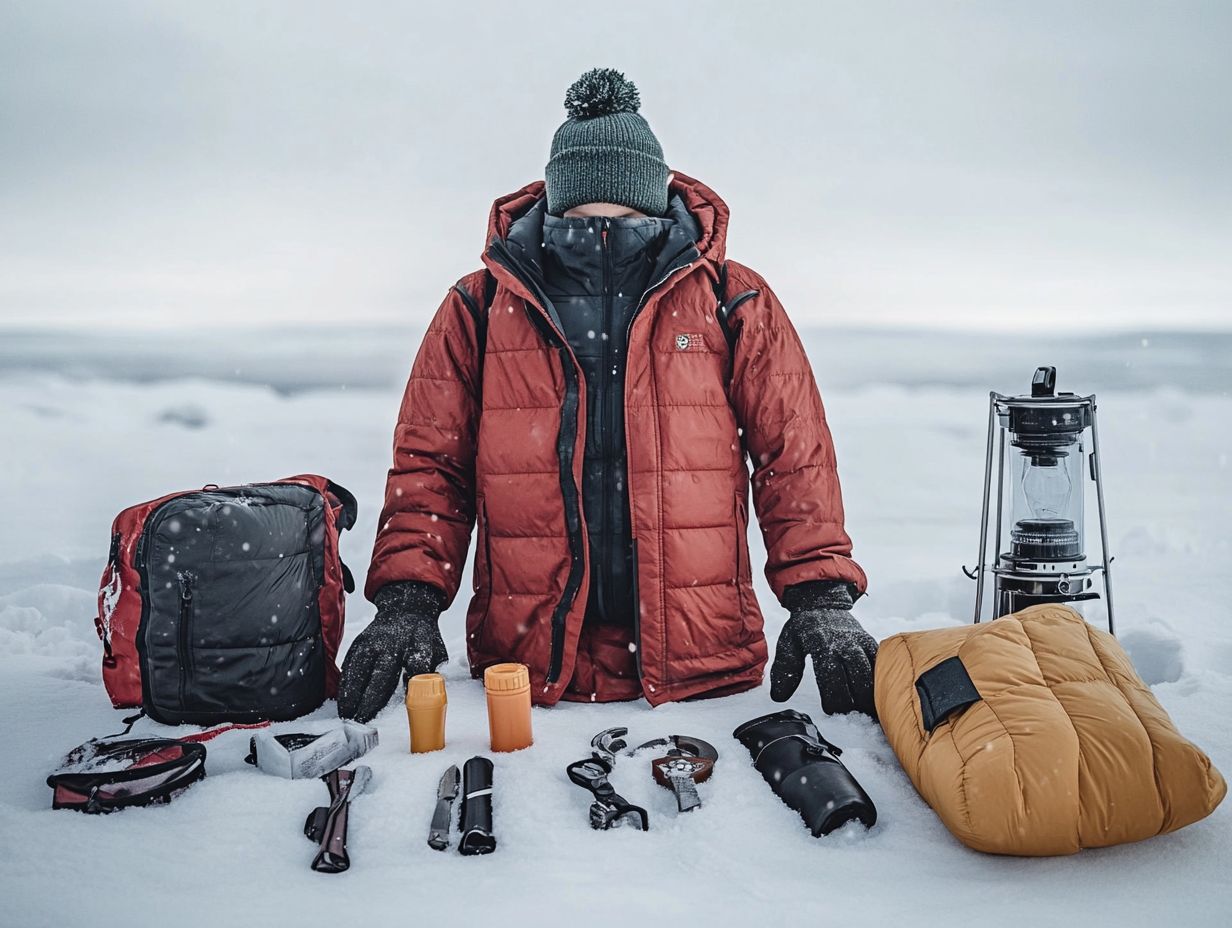
In the dark and unpredictable conditions of winter, having reliable lighting and signaling tools is essential for ensuring visibility and safety during emergencies.
When temperatures drop, you ll find that battery-powered flashlights can be particularly advantageous, maintaining consistent performance when you need it most. Look for models that use lithium batteries they re known for their impressive longevity and ability to function effectively in extreme cold.
On the other hand, solar-powered devices present an eco-friendly alternative, offering a sustainable light source as long as they’ve been charged properly before sunset.
Keep signaling devices like whistles or flares within reach; they can greatly enhance your emergency communications, ensuring you can signal for help when necessary.
Being prepared with the right tools can truly make all the difference in critical winter situations!
8. Personal Hygiene and Sanitation Items
Maintaining personal hygiene and sanitation is essential during winter survival preparation. It helps you stay healthy and ward off illness in those chilly conditions.
In winter, the risk of infections rises. It s crucial to pack hygiene items in your survival kit, including personal hygiene products.
- Hand sanitizers help eliminate germs quickly when soap isn’t available.
- Biodegradable wipes help you stay clean while keeping your environmental footprint minimal.
Don’t forget about toilet supplies, like portable toilet paper or compact hygiene kits. They re vital for your comfort and help prevent potential health issues, especially during winter.
Cultivating good hygiene habits enhances your physical well-being and lifts your spirits during harsh winter days.
9. Emergency Blankets and Sleeping Bags
Emergency blankets and sleeping bags are critical elements of your winter survival gear. They provide essential insulation and warmth in unexpected cold situations.
Emergency blankets trap body heat. Sleeping bags offer thicker insulation for longer warmth.
If you re venturing into extreme environments, the bulk and weight of your gear can affect your mobility. Therefore, portability is a key consideration.
Understanding the differences between these options helps you prepare effectively for emergencies, ensuring you maintain your core body temperature in harsh winter conditions.
10. Hand and Foot Warmers
In cold weather, hand and foot warmers deliver warmth and protect against frostbite. These essential accessories come in various types to suit your preferences.
Disposable warmers are perfect for a day on the slopes; they heat up quickly and can be easily discarded after use.
Conversely, rechargeable options provide a sustainable alternative for repeated use ideal for passionate winter sports enthusiasts or anyone who frequently braves the chill.
Regardless of the type you choose, both play a vital role in ensuring you stay warm and comfortable during your winter adventures.
11. Portable Stove and Fuel
A portable stove is essential for cooking in winter. It provides a reliable means to prepare meals during winter camping or emergencies.
You ll find various portable stove options, including canister stoves, liquid fuel stoves, and wood-burning models. Canister stoves are lightweight and easy to use.
On the other hand, liquid fuel stoves offer versatility, burning various fuels, making them suitable for extended trips.
If you prefer to embrace your surroundings, wood-burning stoves let you use readily available materials, fostering a deeper connection with nature.
Each type of stove lets you cook meals that keep your energy up in the cold.
12. Emergency Whistle
An emergency whistle is an essential addition to your survival kit. It serves as a powerful signaling device when you find yourself in a pinch or in need of assistance.
Unlike shouting, which can drain your energy and only travel a short distance, an emergency whistle can be heard from much farther away. It effortlessly slices through nature’s cacophony. This feature becomes especially invaluable in winter, where wind and snow can distort sounds and make communication challenging.
The loud tone of the whistle allows rescuers to locate you with greater ease. Using a whistle also helps conserve your energy, keeping you alert and prepared to tackle whatever challenges may arise in your survival situation. This simple tool significantly enhances your chances of being rescued when it truly counts.
13. Emergency Radio
An emergency radio is an essential tool for staying informed during winter storms or emergencies. It delivers vital updates on weather and safety information.
These devices not only keep you connected to local broadcasts but also come equipped with features like NOAA weather alerts (National Oceanic and Atmospheric Administration), ensuring you receive timely warnings about severe conditions.
Among the various options available today, solar-powered radios stand out for their sustainability and independence from traditional power sources. Hand-crank radios also offer a reliable power solution, allowing you to generate electricity manually when batteries or other power inputs are unavailable.
Each of these choices plays a vital role in maintaining communication and situational awareness, ultimately enhancing your preparedness for unforeseen events.
14. Waterproof Matches and Lighter
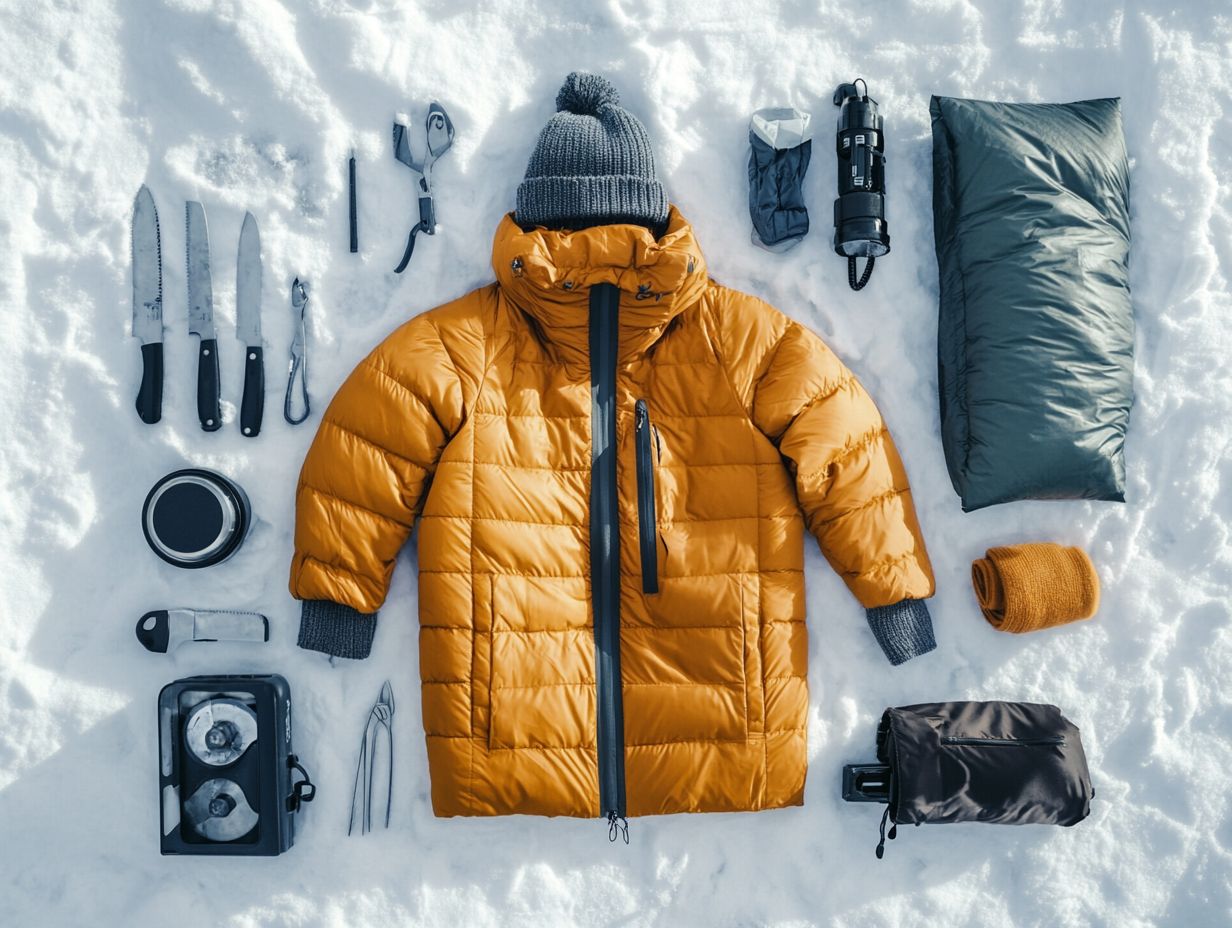
Waterproof matches and lighters are critical fire-starting tools that allow you to ignite a flame even in the harshest, wet conditions. This significantly boosts your winter survival odds.
In emergencies, having reliable equipment can be the difference between life and death. You don t want to worry about whether your fire-starting method will falter because of moisture when faced with inclement weather.
Waterproof options not only withstand dampness but also provide you with peace of mind. This allows you to concentrate on other vital survival needs, like warmth and cooking.
Imagine trying to stay warm in the biting cold without a dependable source of fire! It can swiftly escalate into a desperate situation. That s why incorporating these tools into your survival kit is essential for any outdoor enthusiast or adventurer.
15. Survival Guide and Maps
Having a comprehensive survival guide and detailed maps is absolutely essential for navigating and managing emergency situations in unfamiliar winter environments. These resources equip you with crucial survival strategies and tips, allowing you to make informed decisions when faced with unexpected challenges.
When preparing for such conditions, consider these essential elements:
- Techniques for building shelters
- Gathering food
- Maintaining body heat in cold temperatures
Up-to-date maps are your best friends in navigating treacherous terrains safely, as they highlight potential hazards and alternative routes. A well-prepared individual recognizes the importance of identifying natural landmarks and employing proper signaling techniques to enhance the chances of being located by rescuers.
All these components work together seamlessly to boost your safety and foster resilience in potentially life-threatening conditions.
What Are the Essential Items for Cold Weather Survival?
Preparing for cold weather survival is essential. Knowing the key items you need will keep you safe and comfortable during outdoor activities or emergencies.
Winter preparedness involves clothing, shelter, food, tools, and navigation devices. Layering with insulating and waterproof materials helps regulate body temperature.
Consider portable tents or emergency sleeping bags for shelter. They protect you from harsh weather and help you escape the cold.
Focus on non-perishable food items that are high in energy, such as nuts or granola, to maintain your strength and endurance.
Essential tools, like multi-tools and fire starters, will help you tackle tasks efficiently. Navigation devices will ensure you can find your way even in a snow-covered landscape.
Together, these items form a robust foundation for overcoming the challenges winter throws your way.
What Are Some Tips for Choosing the Right Survival Gear?
Choose survival gear carefully, focusing on durability and functionality. Think about your comfort levels and the activities you plan to do.
Also, consider environmental factors; temperature fluctuations, humidity, and wind conditions are critical in your selection process.
When evaluating winter equipment, look for waterproof materials, quality insulation, and breathability. A layered approach is typically wise, as it provides the flexibility needed for diverse situations.
Pay attention to the fit and weight of the items; they should facilitate movement and stamina rather than hinder them. Prioritizing these considerations can significantly enhance your safety and comfort during survival scenarios.
How Can One Prepare for Cold Weather Emergencies?
Preparing for emergencies requires a solid plan. Start by assembling a survival kit with blankets, non-perishable food, water, and a flashlight.
Next, inform family members or close friends about these preparations. Make sure everyone understands the protocol during an emergency.
Your plan should include practicing emergency scenarios. Rehearse responses to various situations, such as power outages or being stranded in severe weather.
This proactive approach boosts confidence and ensures that everyone knows their role and can act swiftly when the need arises.
What Are the Most Common Mistakes When Choosing Survival Gear for Cold Weather?
Many people make mistakes when choosing cold weather gear. They often overlook important features that affect safety and comfort.
For instance, skimping on adequate insulation in your clothing can lead to rapid heat loss, making outdoor survival a daunting challenge. Non-waterproof materials can leave you with soggy gear, compromising warmth and heightening the risk of hypothermia.
You should also appreciate the unique nature of your environment. Neglecting to prepare for emergency situations, like sudden snowstorms or unexpected temperature drops, can leave you vulnerable.
By addressing these crucial elements, you can ensure you’re well-prepared when you need your gear the most.
How Can One Maintain and Care for Their Survival Gear?
Maintaining and caring for your survival gear is crucial to ensuring its longevity and reliability when you truly need it during cold weather emergencies.
Make it a habit to regularly inspect and clean each item to avoid potential issues when the stakes are high. Start with essentials like sleeping bags and tents. Ensure they re free from dirt and moisture to prevent mold growth.
Store these items in cool, dry places, away from direct sunlight, to preserve their integrity. Check the functionality of tools and gear like flashlights and fire starters. Testing them periodically will keep you prepared.
This proactive approach boosts performance and provides peace of mind, knowing everything will work seamlessly when you re faced with unexpected challenges.
Description: Watch this video to learn more about caring for your survival gear.
Frequently Asked Questions
In this section, we ll answer common questions about cold weather survival gear to help you prepare effectively.
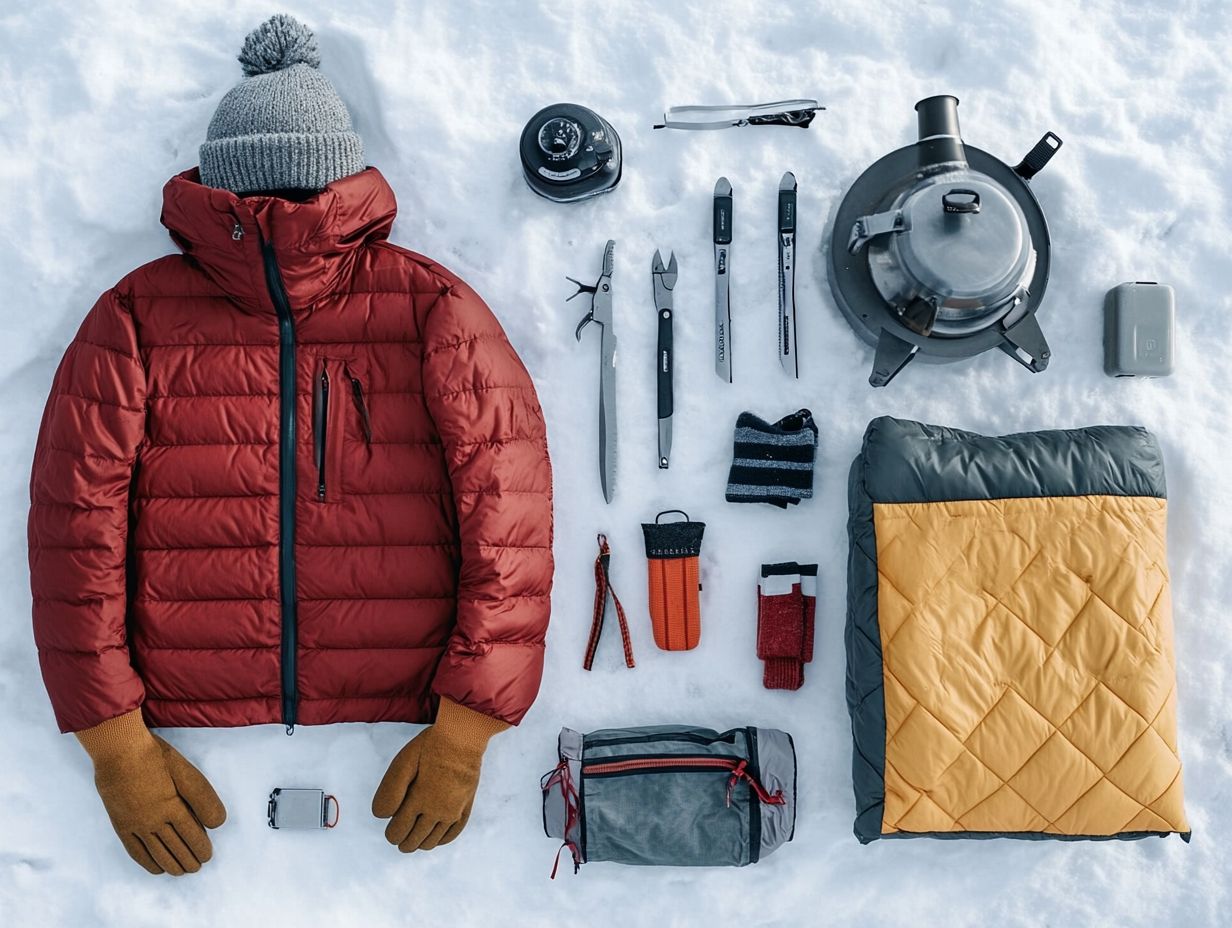
What is the best type of clothing to wear for cold weather survival?
The best clothing for cold weather survival is layers of high-quality materials that draw moisture away from your body, like wool or synthetic fabrics. This helps to keep you warm and dry.
What essential items should I include in my cold weather survival kit?
Essential items for a cold weather survival kit include a waterproof shelter, fire-starting materials, a first aid kit, food and water, and warm clothing.
What type of shelter is best for cold weather survival?
A waterproof shelter, such as a tent or tarp, is ideal for cold weather survival. It protects you from wind and rain while providing insulation for your body heat.
Should I bring a water filter for cold weather survival?
Yes, bringing a water filter is crucial for cold weather survival. Even if water sources are frozen, you can melt ice or snow to obtain drinking water. A filter will help remove impurities.
What type of fire-starting materials should I pack for cold weather survival?
Pack a variety of fire-starting materials for cold weather survival, including waterproof matches, a fire starter, and flint and steel. It’s also helpful to have kindling and dry tinder, like cotton balls or dryer lint, to start the fire.
Is it important to have a first aid kit for cold weather survival?
Having a first aid kit could be a lifesaver in harsh cold! Cold temperatures and tough conditions increase the risk of injury, so it’s essential to have supplies on hand to treat minor injuries.
Now is the time to prepare your survival gear to ensure you’re ready for whatever challenges winter throws your way!

